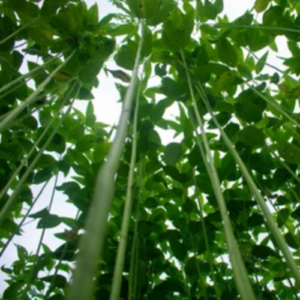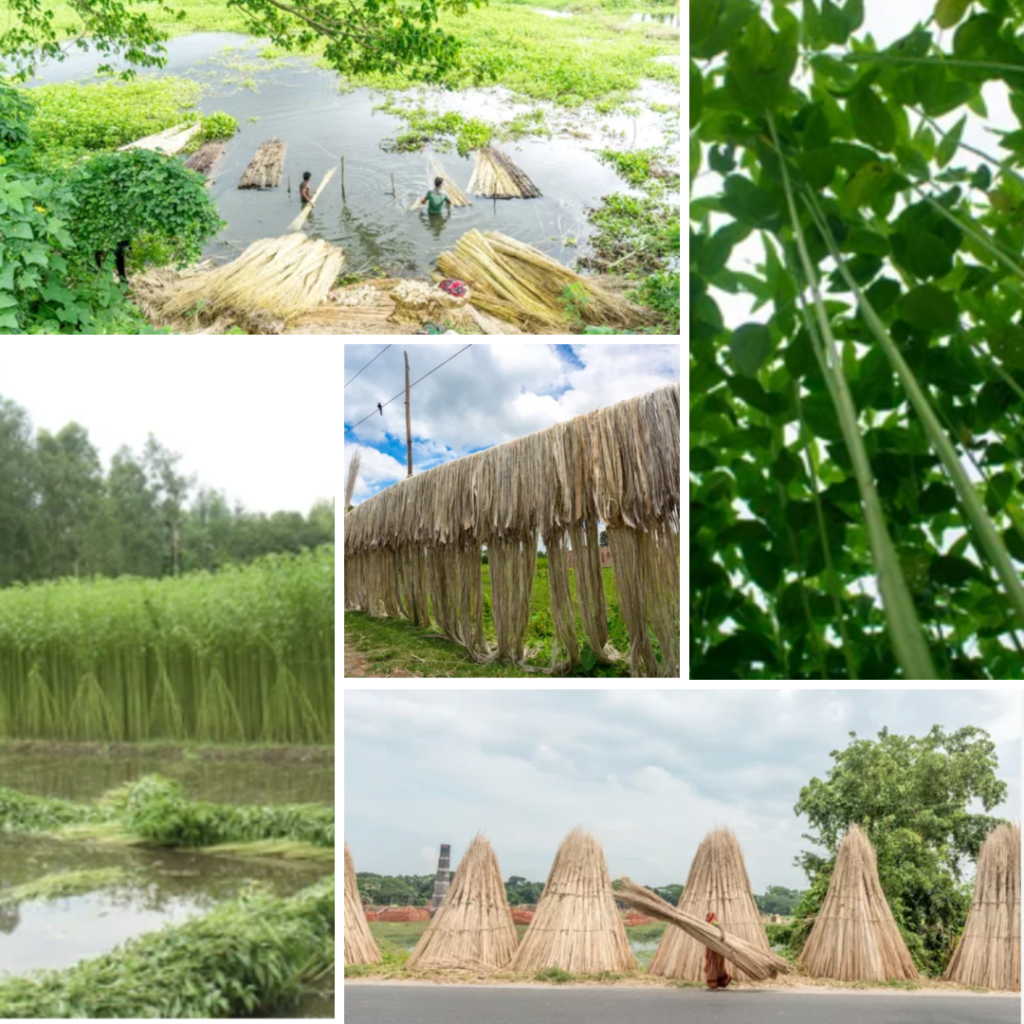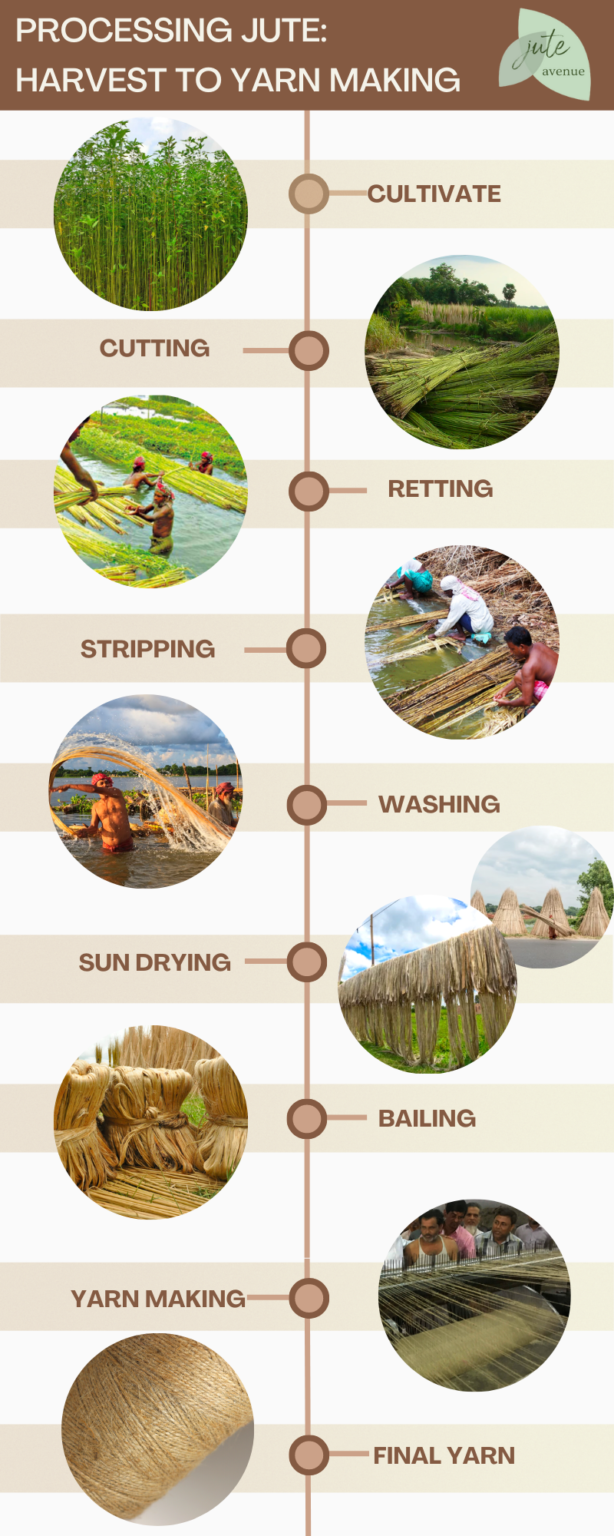About Jute
Jute
is a solution to Climate Change
Jute is an amazing gift of nature. It is a natural golden fibre that has been in use since ancient times. With its inherent strength, jute has been used to create everything from bags, mats, ropes and even cloths.
Jute is made from a plant that grows in tropical climates and can be harvested without harming the land or wildlife. Produced from flowering plants in the genus Corchorus, jute is known as the golden fibre of Bangladesh as it grows exclusively in this region. Bangladesh produces 90% of the world’s jute. This plant produces long, fine fibres that can be used in the production of a range of diverse products. Fibres are light and soft with a golden sheen on top of their yellowish-brown tint. Jute is also quick and simple to grow.
Jute is an amazing gift of nature. It is a natural golden fibre that has been in use since ancient times. With its inherent strength, jute has been used to create everything from bags, mats, ropes and even cloths.
Jute is made from a plant that grows in tropical climates and can be harvested without harming the land or wildlife. Produced from flowering plants in the genus Corchorus, jute is known as the golden fibre of Bangladesh as it grows exclusively in this region. Bangladesh produces 90% of the world’s jute. This plant produces long, fine fibres that can be used in the production of a range of diverse products. Fibres are light and soft with a golden sheen on top of their yellowish-brown tint. Jute is also quick and simple to grow.

Zero waste
Jute does not leave any waste behind; it disintegrates in the soil in under 2 years.
Recyclable
Jute goods can be used over and over again. They’re strong to carry a lot more weight than polythene and paper bags.
Energy saving
The fibre extraction of jute, called Retting involves no machineries. This is done by water or microbial and is a century-old process hence it saves energy.
Net zero emission
- Regenerative Annual Cropping
- Forest Protection: Alternate to woods and growing time is much less
- Composting as it returns to the soil
- Conservation agriculture uses cover crops, crop rotation, and minimal tilling to produce annual crops.
No Greenwashing
Greenwashing is a term used to describe a false, misleading or untrue claim about the positive impact that a company, product or service has on the environment. Jute is a 100% environmentally friendly asset to the planet.
Cradle to Cradle (C2C)
Maximum reuse of resources and proposes eliminating the concept of waste. The theory suggests designing and developing products in a way that there is no waste, but just nutrients (a starting point) for something new.
An example of a C2C product is Jute with recycling, zero waste and return to the soil.
Jute - A Conscious Choice
Jute -
A Conscious Choice

- 100% biodegradable and recyclable.
- Jute is a sustainable alternative to plastic and other synthetic materials with a low to zero carbon footprint.
- Jute does not disrupt the climate or ecosystems.
- Because of its low cost and biodegradable composition, it’s one of the best economical and environmental choices.
- Reduces waste removal costs while increasing recycling rates.
- Strong and durable.
- Well suited for bulk agricultural and industrial packaging.
- One of the oldest and the most commonly used packaging material.
- Easily printable and customizable.
- Reduces loss of product by preventing rot and deterioration caused by trapped moisture.
- Significantly absorbs moisture while allowing airflow.
- Pesticides, herbicides and fertilizers are not as necessary for growing the jute plant. There is a rapid turnover and a continuous supply of new fibre because the jute growing season lasts only about 100 days.
- According to studies, throughout the jute growth season, one hectare of jute plants can absorb up to 15 tons of carbon dioxide, a greenhouse gas, and release up to 11 tons of oxygen. When crops are rotated after the jute has been sown, it restores the nutrients in the soil and lowers the danger of pests and disease.
Products Jute can Replace!
- Single Use Plastic Bags.
- Mesh Bags or polypropylene woven bags to package onions, potatoes, firewood etc.
- BOPP – Biaxially Oriented Polypropylene bags for animal feed, building materials etc.
- Sandbags made from polypropylene for flood control etc.
- Geosynthetics or geotextiles, made from polypropylene or polyester, are used as soil saver, erosion control, hill slope management etc.
- Artificial breathable Fabric to cover trees for protection in winter.
- Root balling when transplanting a tree.
- Curing concrete with plastic film or reinforced paper in construction.
- PP Lumber shield to cover raw lumber.
- Drill wipe in mining & drilling industry use.

